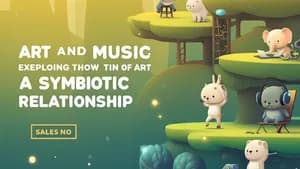This article delves into the rich history of art and music in ancient civilizations, examining how these disciplines were intertwined in rituals, ceremonies, and cultural expressions. From the intricate musical instruments and vibrant wall paintings of ancient Egypt to the celestial observations and musical scales of ancient Greece, this piece showcases the deep historical roots of the symbiotic relationship between art and music.
The Harmony of Ancient Egypt
Ancient Egypt, known for its enduring monuments and captivating art, also possessed a vibrant musical tradition. Imagine, for a moment, standing in a grand temple, the air filled with the sound of lutes, harps, and flutes as priests and worshippers perform hymns to honor the gods. Music was an integral part of daily life, religious ceremonies, and even royal entertainment. Paintings depicting musicians playing instruments like the sistrum (a percussion instrument) and the double clarinet are common on tomb walls. You can find these depictions in places like the tomb of Ramesses III, showcasing the importance of music in Egyptian society. As you delve into ancient Egyptian art, pay attention to the recurring motifs of musical instruments and dancing figures, understanding how these elements reveal the deep integration of music and visual arts.
The Celestial Symphony of Ancient Greece
Ancient Greece, renowned for its philosophical and scientific contributions, also held music in high regard. Think of the majestic marble sculptures of the Parthenon, the epic poems of Homer, and the philosophical dialogues of Plato – all of these were deeply influenced by music. The Greeks believed that music had a powerful influence on the human soul, capable of evoking emotions and fostering harmony. They developed intricate musical scales and modes, associating specific musical intervals with emotions like joy, sorrow, and anger. The philosopher Plato, for instance, believed that music could shape a person's character. The Greeks even used music in their education system, considering it essential for a well-rounded individual. As you study ancient Greek literature, you'll find references to music in epics like the Iliad and the Odyssey. When you come across these, consider the impact of music on the characters and the themes explored in these works.
The Rhythmic Tapestry of Ancient Rome
Ancient Rome, a civilization known for its grand architecture and military prowess, also embraced the power of music. Imagine the bustling atmosphere of a Roman circus, where crowds cheered as gladiators fought, accompanied by the resounding beat of trumpets and the rhythmic clash of cymbals. Music played a significant role in religious ceremonies, theatrical performances, and even in the military. Romans incorporated music into their everyday lives, using it for entertainment, social gatherings, and even as a tool for education. The Romans were particularly fond of instrumental music, with instruments like the lyre, the flute, and the trumpet being commonly used. As you explore Roman history and culture, pay attention to the use of music in different contexts. Examine how the Romans integrated music into their public spaces, their rituals, and their celebrations. The Coliseum, for example, was not just a place for gladiatorial combats but also a space for musical performances.
The Echoes of Antiquity in Modern Times
The art and music of ancient civilizations continue to resonate today, influencing our own artistic expressions and musical traditions. Modern composers draw inspiration from ancient Greek scales and modes, while artists find inspiration in the symbolic imagery of Egyptian art. You can observe the influence of ancient Greek music on the development of Western music, with the ancient Greek musical scales forming the foundation of many musical systems. Look for examples in the works of composers like Bach, Beethoven, and Mozart. You can also see the influence of ancient Egypt in modern art, with artists like Picasso and Matisse drawing inspiration from the vibrant colors and geometric patterns of ancient Egyptian art. As you experience art and music today, consider the long historical threads that connect us to ancient civilizations. Be mindful of the echoes of antiquity in the music you listen to and the art you encounter.
Conclusion
The ancient world, brimming with artistic expression and musical tradition, offers a unique opportunity to delve into the historical roots of art and music. By studying these ancient civilizations, you can understand the interplay between visual and auditory art, and gain a deeper appreciation for the cultural context in which these artistic expressions arose. You can also discover the deep connections between ancient art and music, and how these connections continue to influence our modern artistic experiences. As you embark on your learning journey, remember that art and music are more than just aesthetics—they are expressions of human experience, cultural values, and spiritual beliefs that have resonated across generations. Embrace the echoes of antiquity in your own artistic explorations, and allow these echoes to inspire your own creativity and understanding of the world around you.

